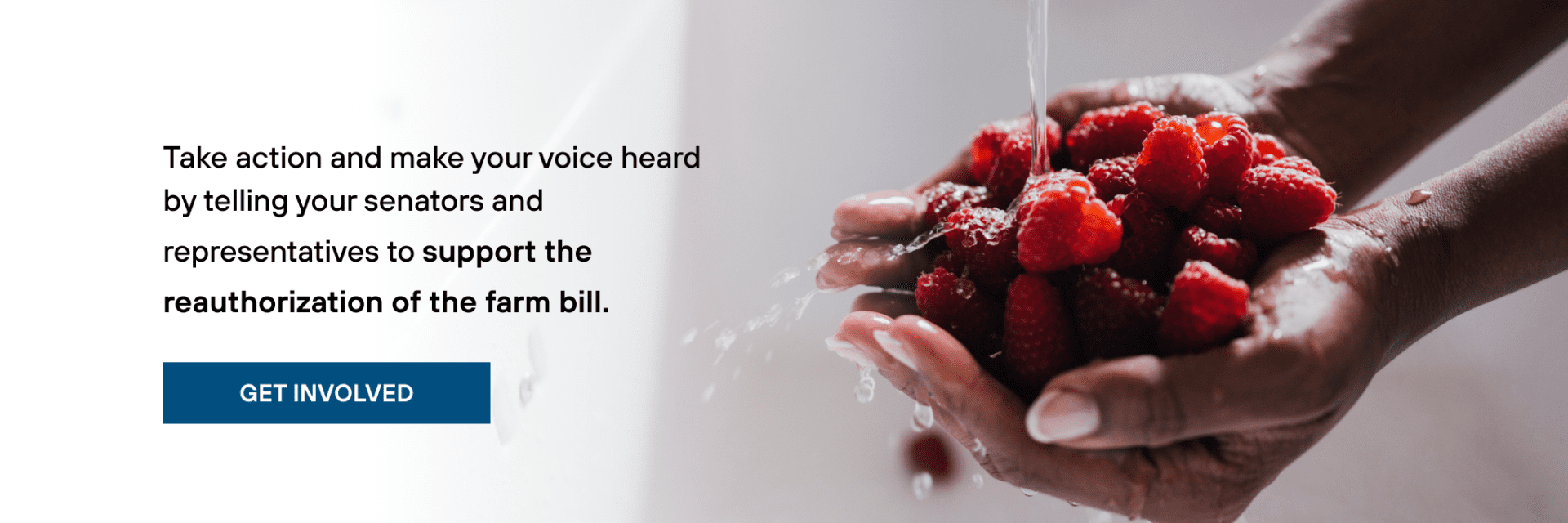The farm bill is legislation that is critical to ending hunger in the U.S. and internationally. It doesn’t just affect farmers. It also impacts every person in the U.S. who eats and buys food, as well as those facing hunger internationally.

The farm bill sets national policies for nutrition, agriculture, conservation, and forestry. It provides nutrition assistance to millions of Americans through programs such as SNAP (Supplemental Nutrition Assistance Program), which typically gets the largest funding share of any program in the farm bill.
The farm bill is due to be reauthorized by Congress every five years; the most recent farm bill was enacted into law in 2018, and it expired in 2023. When Congress delays reauthorization, the existing farm bill has to be extended until the next one is completed. Programs included in the farm bill provide lifesaving assistance to millions of people facing dangerous levels of hunger and malnutrition, both in the U.S. and around the world.
In this article, we will discuss:
- What is the farm bill?
- What is included in the farm bill?
- How much does the farm bill cost?
- What federal programs are authorized in the farm bill?
- Why is the farm bill important for ending hunger in the U.S.?
- Does the farm bill provide global food assistance?
- What is Bread for the World advocating for in the 2023 farm bill?
- Was the farm bill reauthorized in 2023?
- What happens if the farm bill expires?
What is the farm bill?
The farm bill is an enormous package of policies and programs that is reauthorized by Congress every five years and sets the nation’s agricultural and food policies. The bill governs both U.S. and global programs and impacts everything from the price and quality of the food we eat to the health and sustainability of the nation’s farms and natural resources.
Since the 1930s, Congress has enacted 18 farm bills. Each farm bill has several unique titles, such as conservation, nutrition, rural development, trade, and others; but the omnibus package of legislation as a whole is commonly referred to as the “farm bill.” The farm bill that expired in 2023 is called the “Agriculture Improvement Act of 2018.” President Trump signed the 2018 farm bill into law on December 20, 2018.
Reauthorizing the farm bill gives Congress an opportunity to improve food and nutrition security through several federal nutrition assistance programs.
What is included in the farm bill?
The farm bill governs a variety of agricultural and food programs. The farm bill has become increasingly expansive in the past several decades. It has an important impact not just on nutrition assistance for Americans but on how food is grown and what kinds of foods are prioritized in agricultural policy.
The current (2018) farm bill has twelve chapters, called titles:
Title 1: Commodities.
What it covers: Price and income support for the farmers who grow crops like corn, wheat, soybeans, rice, and sugar (it also includes dairy).
Title 2: Conservation.
What it covers: Natural resource conservation efforts on farms and ranches.
Title 3: Trade.
What it covers: Food export subsidy programs and international food aid programs.
Title 4: Nutrition.
What it covers: The Supplemental Nutrition Assistance Program (SNAP) and other nutrition programs.
Title 5: Credit.
What it covers: Federal loan programs that help farmers access loans.
Title 6: Rural Development.
What it covers: Programs for rural businesses, housing, and infrastructure.
Title 7: Research, Extension, and Related Matters.
What it covers: Farm and food research and education, such as training for farmers and ranchers.
Title 8: Forestry.
What it covers: Forest conservation programs.
Title 9: Energy.
What it covers: Programs for growing crops for biofuel and helping farmers install renewable energy systems.
Title 10: Horticulture.
What it covers: Farmers market programs, organic farming and certification programs.
Title 11: Crop Insurance.
What it covers: Subsidies to farmers and private crop insurance companies to protect against losses in crop yield or revenue.
Title 12: Miscellaneous.
What it covers: Agricultural labor safety, livestock health, and support for beginning farmers and socially disadvantaged farmers, such as farmers of color and female farmers.
How much does the farm bill cost?
The total cost of the 2018 farm bill is about $428 billion over the 5-year period 2019–23.
The majority of the farm bill’s funding is for nutrition programs, which accounted for about three-quarters of farm bill spending from 2019 to 2023.
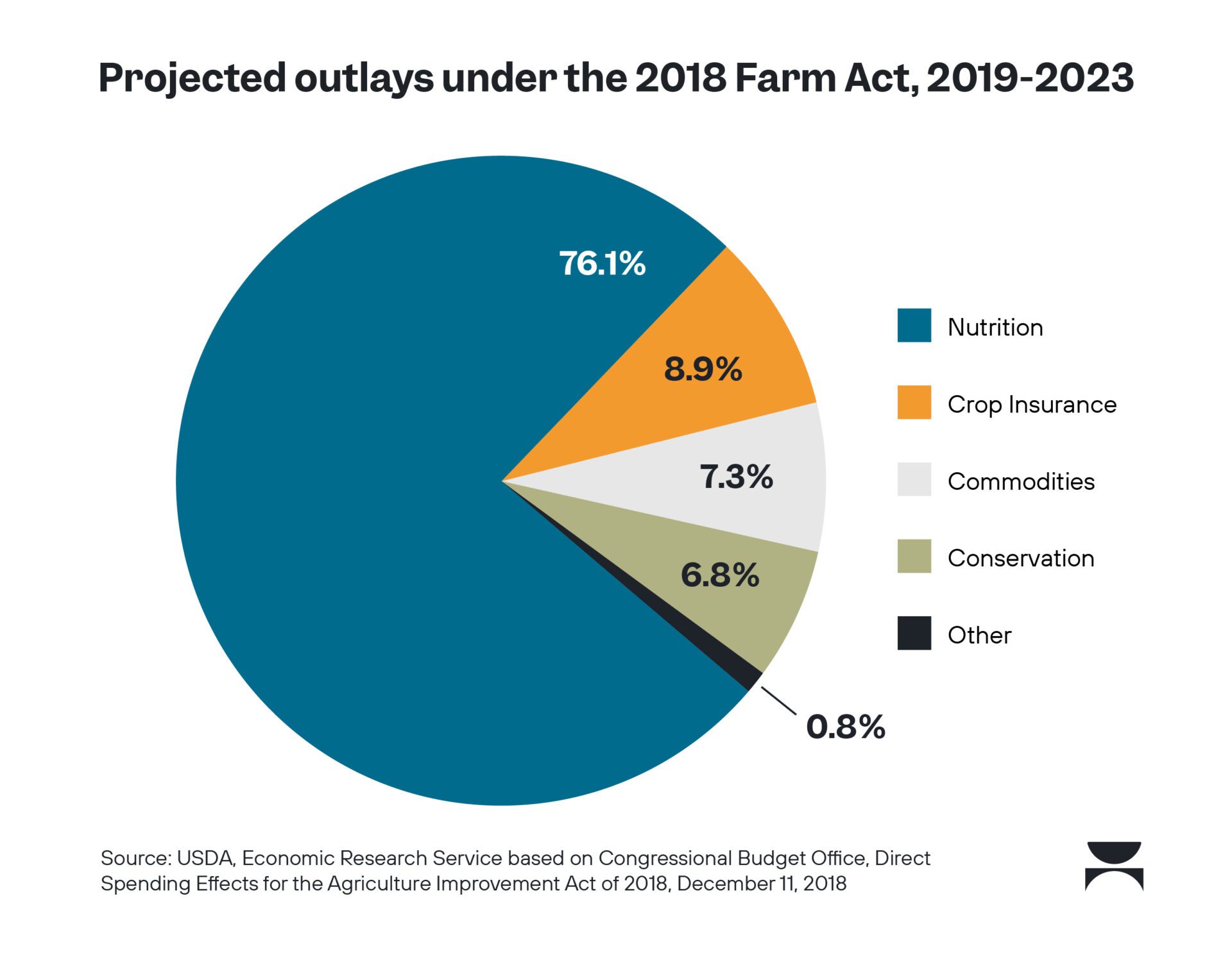
According to the Congressional Budget Office, the next farm bill is estimated to be the first-ever farm bill to exceed $1 trillion. Nutrition is projected to make up more than 80% of the total farm bill spending.
What federal programs are authorized in the farm bill?
The major federal nutrition assistance programs authorized in the farm bill are:
- Supplemental Nutrition Assistance Program (SNAP), formerly the food stamp program
- The Emergency Food Assistance Program (TEFAP)
- Food Distribution Program on Indian Reservations (FDPIR)
- Commodity Supplemental Food Program (CSFP)
- Fresh Fruit and Vegetable Program (FFVP)
- Seniors Farmers’ Market Nutrition Program (SFMNP)
- Healthy Food Financing Initiative (HFFI)
- Community Food Projects
- The Gus Schumacher Nutrition Incentive Program (GusNIP)
Why is the farm bill important for ending hunger in the U.S.?
The farm bill impacts hunger in the United States by providing access to nutritious food for millions of Americans struggling with hunger.
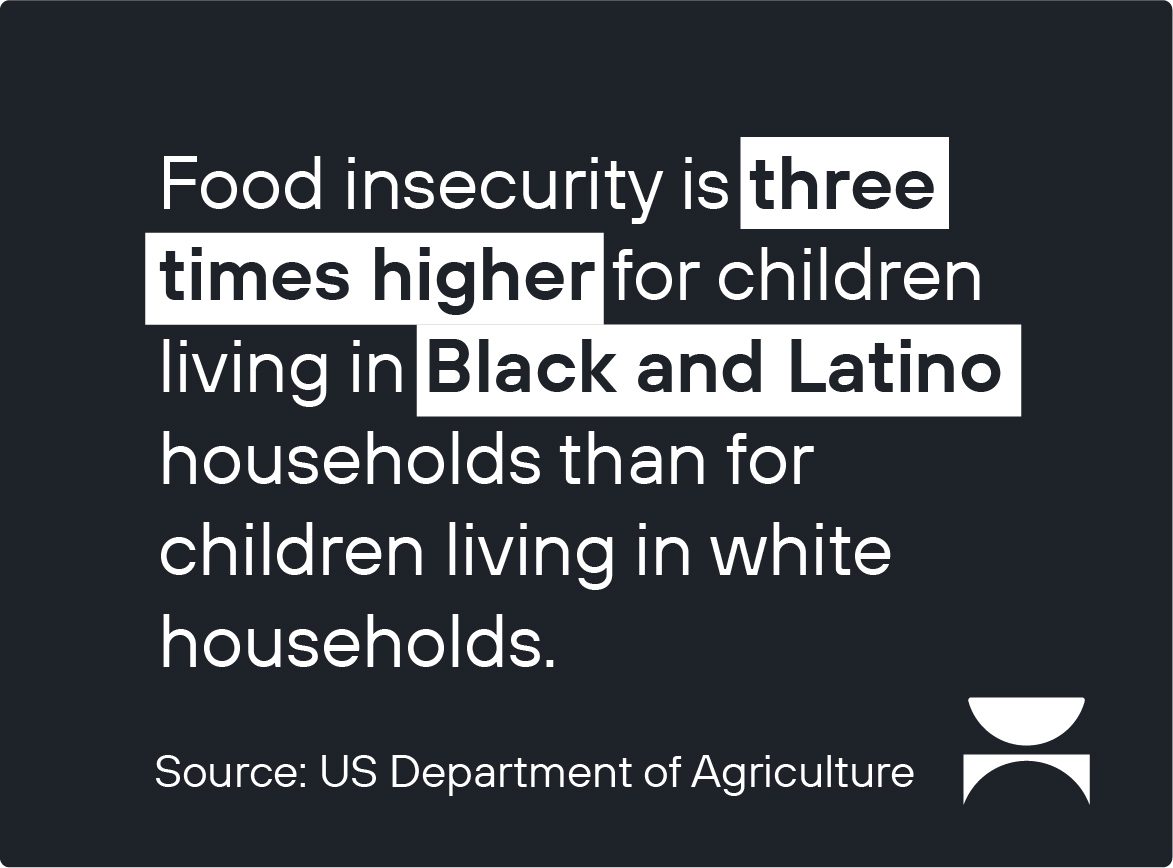
Feeding Families
Hunger exists in the U.S. just as it does overseas. In the U.S., low-income households spend a greater share of their income on food, and more than one in five U.S. children are at risk of hunger.
Food insecurity is three times higher for children living in Black and Latino households than for children living in white households. Programs included in the farm bill are vital for getting nutritious food to individuals and families so they can live thriving, productive lives.
Supplemental Nutrition Assistance Program
The U.S. flagship nutrition program and the main vehicle for reducing hunger under the bill is the Supplemental Nutrition Assistance Program (SNAP) – formerly food stamps – which currently serves more than 41 million people.
Research shows that SNAP is one of our most effective tools in reducing hunger and food insecurity.
SNAP helps families put food on the table but is rarely enough to ensure an adequate amount of healthy food. SNAP recipients, on average, consume lower amounts of fruits and vegetables than the average American. The Gus Schumacher Nutrition Incentive Program (GusNIP) is an indispensable enhancement to SNAP by providing additional benefits to purchase fruits and vegetables.

The Emergency Food Assistance Program
Another important program authorized by the farm bill is The Emergency Food Assistance Program, or TEFAP, a federal nutrition program that moves food from farms to food banks to people facing hunger. Through this program, the U.S. Department of Agriculture purchases healthy foods from U.S. farmers for food banks and other organizations to distribute.
These and other farm bill programs address long-standing nutritional inequities to ensure that marginalized and underserved communities receive nutritious food.
For example, the Fresh Fruit and Vegetable Program (FFVP) promotes fresh fruits and vegetables in high-need elementary schools throughout the United States. The Seniors Farmers Market Nutrition Program (SFMNP) provides low-income seniors with access to locally grown fruits, vegetables, honey, and herbs. The Food Distribution Program on Indian Reservations (FDPIR) offers a wide variety of fresh fruits and vegetables, frozen meats, whole grains, and traditional foods.
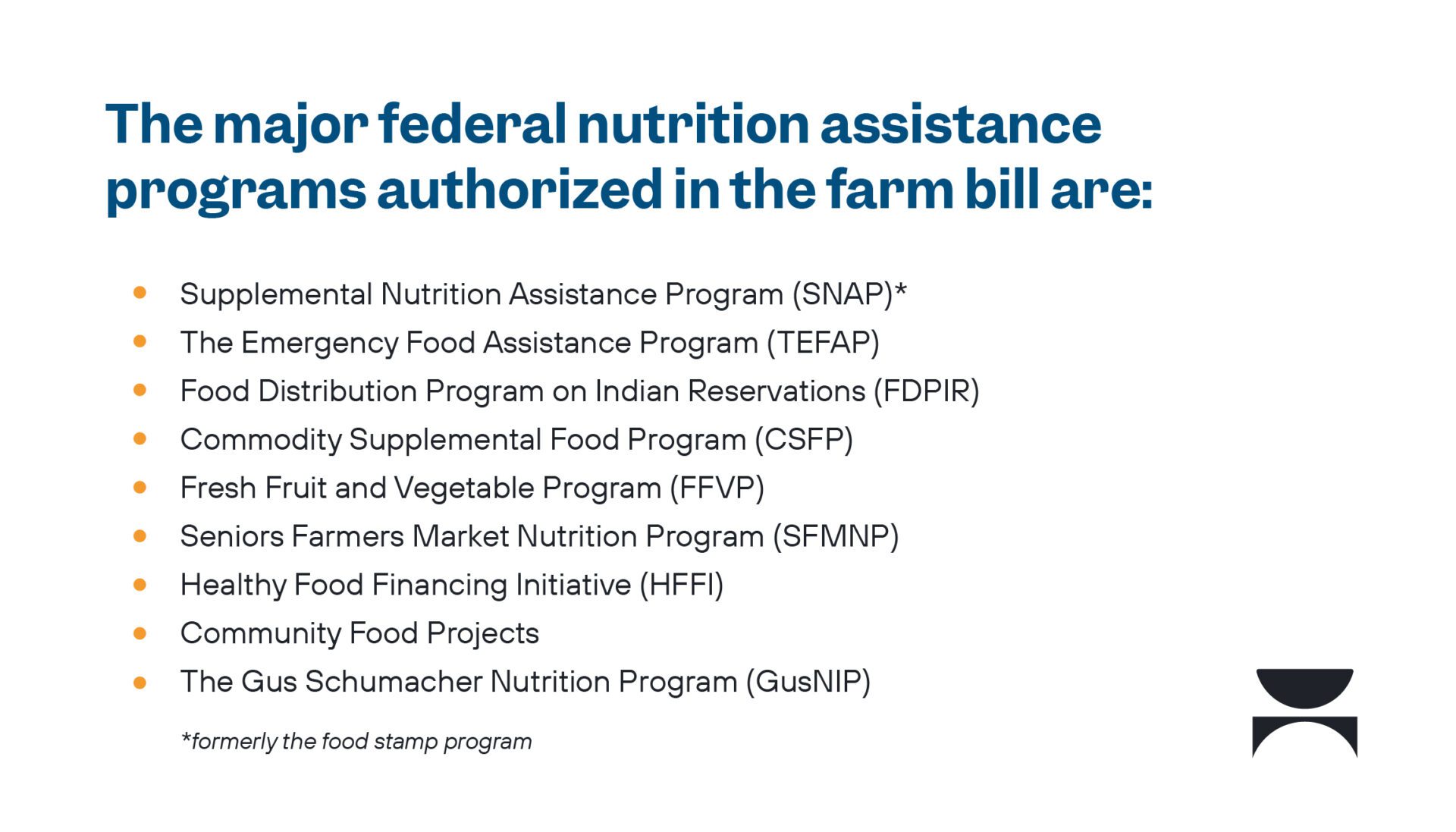
Does the farm bill provide global food assistance?
The farm bill governs both U.S. and global agricultural and food policies and programs. The United States is a leading contributor to global efforts to save lives and relieve suffering among people who confront hunger and malnutrition.
The farm bill spells out the main ways the United States provides emergency nutrition assistance as well as long-term development support to help communities become more resilient to chronic challenges and sudden shocks.
Since 1954, U.S. assistance has reached more than 4 billion people in 150 countries.
The main causes of the current global hunger crises are conflict, climate change, and shocks such as the COVID-19 pandemic. The next farm bill offers an opportunity to increase funding for solutions that will reduce hunger and malnutrition for people around the world who are suffering from the impacts of these crises.
Global food aid comes in three forms: in kind, meaning food shipped from the United States; vouchers to purchase food at local markets; and food purchased from local farmers and distributed to families.
Historically, U.S. food assistance was exclusively in kind. But shipping food from the United States delays the arrival of much-needed supplies, sometimes for months. It also adds significantly to the costs. Meanwhile, people suffering from severe malnutrition urgently need all available resources.

This is why Bread for the World members have worked diligently over several five-year farm bill cycles to persuade Congress to permit a larger share of food aid to be purchased locally or regionally. These efforts have paid off: In 2020, 59% of U.S.-provided emergency food was purchased locally or regionally – an increase from 11% in 2010.
Important global nutrition assistance programs included in the farm bill are:
- Food for Peace
In fiscal year 2022, Food for Peace programs provided $2.6 billion across 31 countries in food assistance to women, children, and communities in hunger hotpots.
- The McGovern-Dole International Food for Education and Child Nutrition Program
This program has enabled food-insecure countries to establish school feeding programs for preschool and primary school children in need, providing 5 billion school meals since it was created 20 years ago. - The Bill Emerson Humanitarian Trust
The Bill Emerson Humanitarian Trust makes funds available to provide emergency humanitarian food assistance to developing countries. - The John Ogonowski and Doug Bereuter Farmer-to-Farmer Program
This program provides technical assistance to farmers, agribusinesses, and other agriculture sector institutions in developing and transitional countries.
What is Bread for the World advocating for in the 2023 farm bill?
The farm bill strengthens nutrition security in the United States by increasing access to healthy food. Bread supports a farm bill that will help build a healthy, equitable, and sustainable U.S. food and agricultural system.
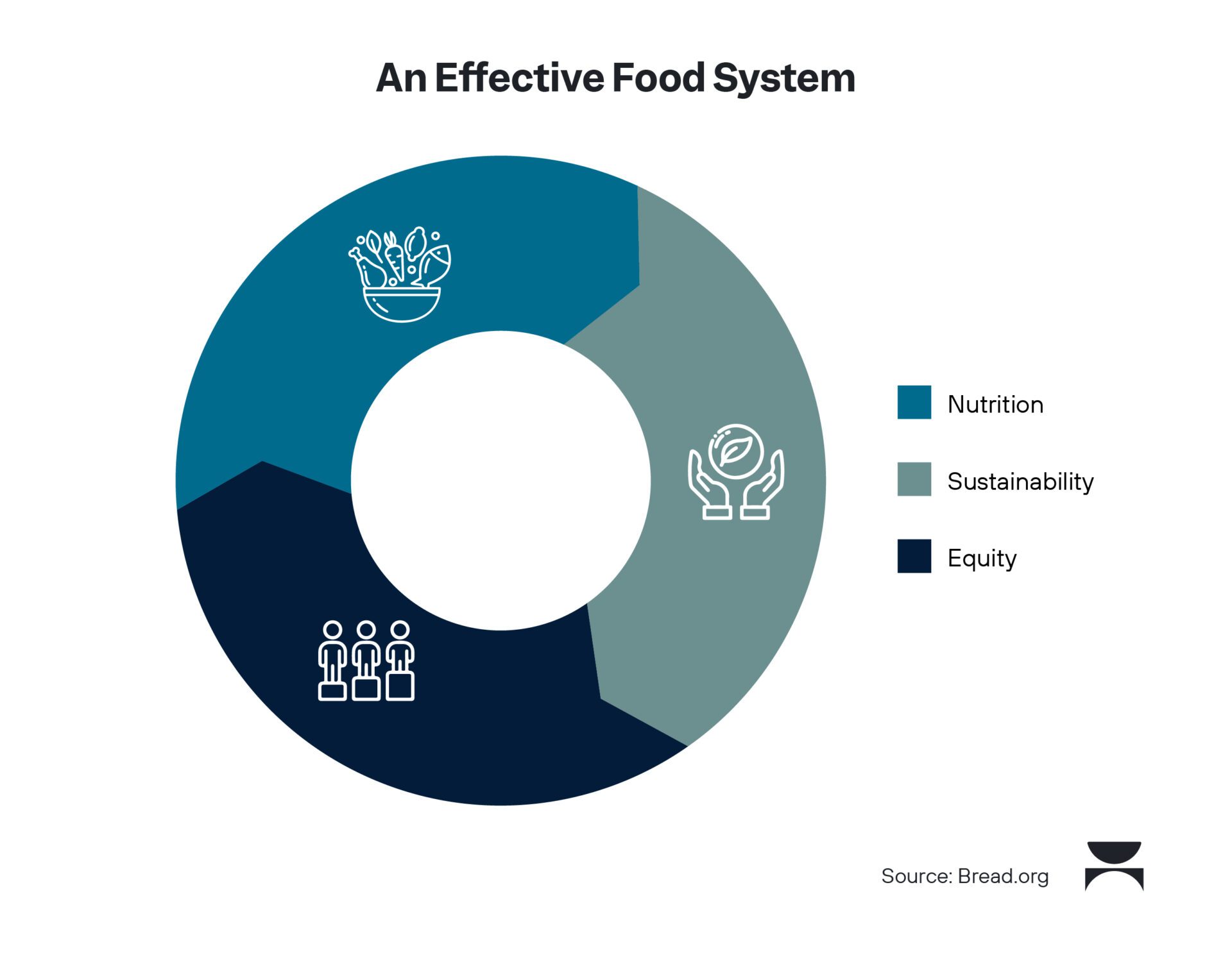
Bread advocates for measures in the next farm bill that will enhance nutrition, nutrition equity, and sustainability in the United States and globally, including:
- Enhanced global maternal and child nutrition through U.S. food aid initiatives
- Expanded access to SNAP among marginalized populations
- Equitable opportunities for all food producers
- Self-governance and food sovereignty for Tribal Nations
- Increased resources for food aid to reach people in crisis as quickly and efficiently as possible
- Funding for programs, research, and policies that address the threat to food security posed by the climate crisis
- Increased support for post-harvest food recovery to reduce food waste and feed people experiencing food insecurity, and reduce the greenhouse gasses that contribute to climate change when food ends up in landfills.
Bread’s advocacy agenda is a result of more than 100 meetings with grassroots advocates and stakeholders, including Black, Hispanic, and Indigenous farmers and food system leaders, Historically Black Colleges and Universities, U.S. Department of Agriculture officials, and local food system leaders.
In 2023, Bread staff met with congressional offices in leadership positions on Senate and House Agriculture committees and subcommittees to introduce Bread’s farm bill policy team to them and gain insight on what Senate and House members could be expected to prioritize in the farm bill. These meetings and consultations also informed Bread’s farm bill policy platform in 2023.
The Current State of the Farm Bill
Was the farm bill reauthorized in 2023?
No, Congress missed their September 30, 2023, deadline for passage of a farm bill.
Debate over the more-than-$1 trillion price tag is part of the reason the farm bill was not reauthorized. Some lawmakers want to cut back on SNAP benefits and initiatives designed to help farmers improve their yields and address climate challenges. There are also disagreements over funding levels for farm subsidy programs.
Reduced funding for SNAP would put more American families at risk of food insecurity.
What happens if the farm bill expires?
If the farm bill expires without a new bill in place or if programs are not granted an extension by Congress, programs face one of three scenarios. Some lose the funding to operate and must shut down. A few key programs, like SNAP, would continue, but others that America’s farmers rely on to sustain their enterprises would revert back to outdated laws from 1938 and 1949 farm bills.
How is the farm bill reauthorized?
The farm bill is reauthorized when it is passed by the House and the Senate and signed into law by the president of the United States.
Typically, committees in the House and the Senate both draft versions of the bill, then debate and revise them until the bills pass in both chambers. Then the bills are combined and must be voted on and passed by both the House and Senate before being sent to the president.
How can you make a difference in the passage of the farm bill?
Leaders in Congress really do listen to their constituents. Get involved by adding your voice to those calling for the reauthorization of the farm bill.
Every letter you write to your representatives on Capitol Hill is read and cataloged – and tells your representative which issues to prioritize.
Look up your senators and representatives using our free search tool, write them a message and share it with those in your community.
Conclusion
The farm bill is our nation’s most important national food system legislation. It is critical to the work of ending hunger at home and abroad.
According to the U.S. Department of Agriculture’s Economic Research Service (USDA ERS), in 2022, 44.2 million people lived in food-insecure households. The reauthorization of the farm bill is a vital step toward ensuring that Americans – and others around the world – can have access to and afford a healthy, balanced diet.
Bread for the World encourages U.S. senators and representatives to support a farm bill that will help build a nutritious, equitable, and sustainable U.S. food and agricultural system.

